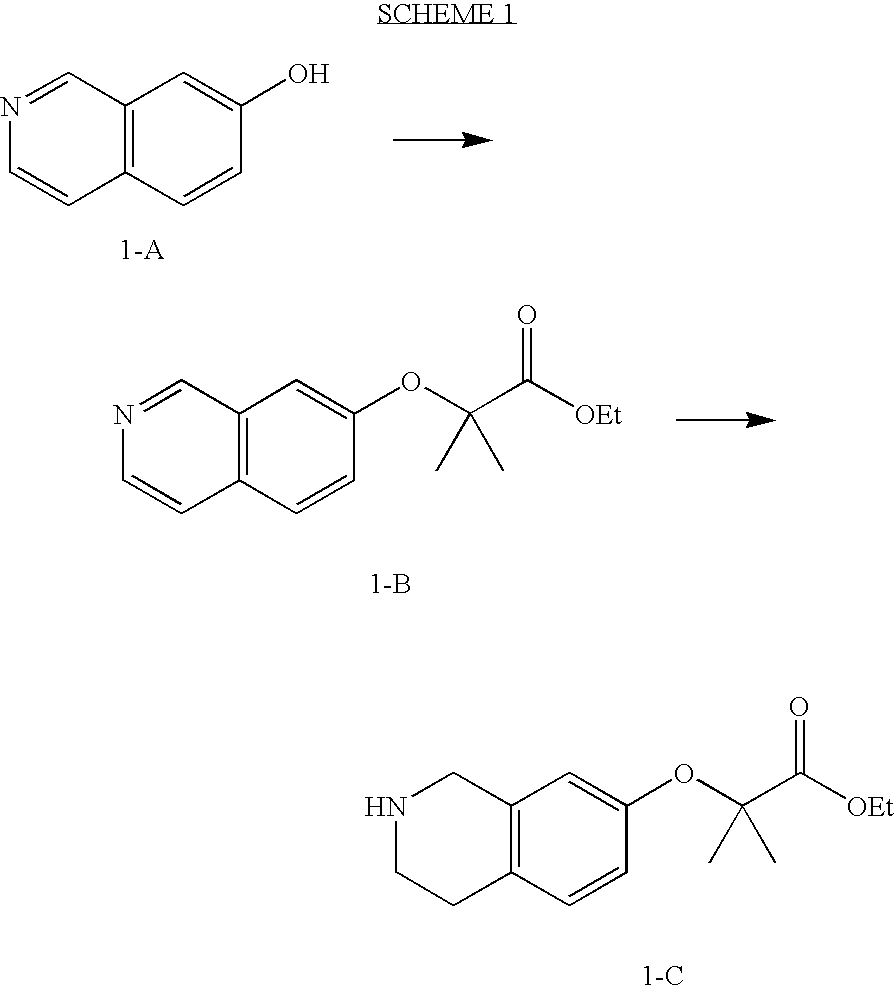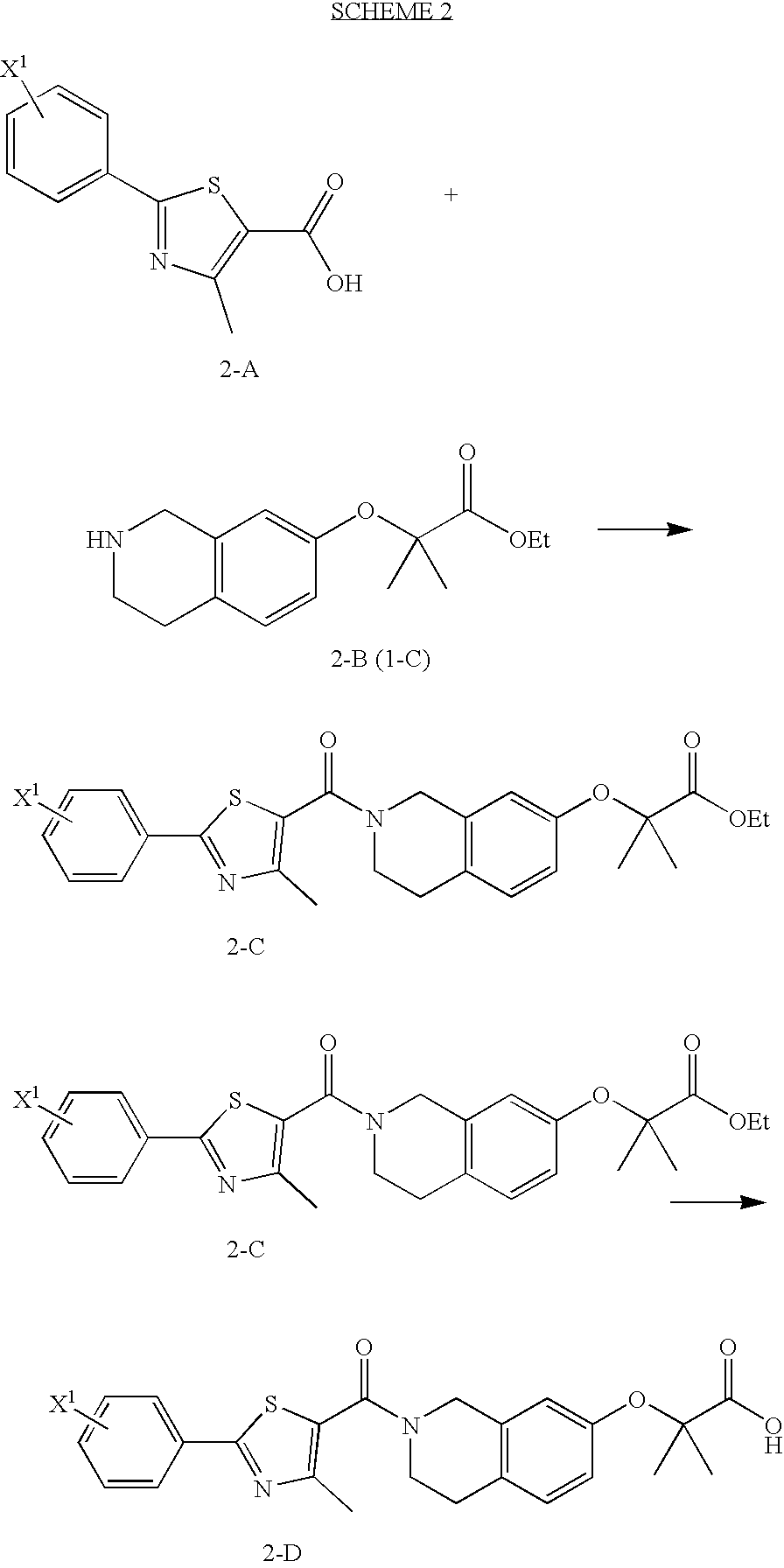Tetrahydroisoquinoline derivatives as PPAR-alpha activators
a technology of tetrahydroisoquinoline and activator, which is applied in the direction of drug composition, extracellular fluid disorder, metabolic disorder, etc., can solve the problems of limiting the use of hypoglycemic agents, large segments of western populations now realized to be at particularly high risk, and side effects of clinically available hypoglycemic agents
- Summary
- Abstract
- Description
- Claims
- Application Information
AI Technical Summary
Benefits of technology
Problems solved by technology
Method used
Image
Examples
preparation 1
2-(Isoquinolin-7-yloxy)-2-methyl-propionic acid ethyl ester
[0358]
[0359]7-Hydroxyisoquinoline (500 mg, 3.4 mmol), ethyl 2-bromoisobutyrate (3 g, 15 mmol) and potassium carbonate (2.1 g, 15 mmol) were mixed in 7 ml of anhydrous DMF. The reaction was heated to 95° C. under N2 for 18 hrs. The reaction was concentrated under reduced pressure and purified by flash column chromatography (33% EtOAc / Hexanes) to yield 470 mg (53%) of the title product of this preparation as a yellow oil.
[0360]1H NMR (400 MHz, CDCl3) δ 9.08 (s, 1H), 8.41 (d, 1H), 7.72 (d, 1H), 7.57 (d, 1H), 7.33 (dd, 1H), 7.13 (d, 1H), 4.25 (q, 2H), 1.69 (s, 6H), 1.22 (t, 3H).
preparation 2
2-(1,2,3,4,4a,8a-Hexahydro-isoquinolin-7-yloxy)-2-methyl-propionic acid ethyl ester
[0361]
[0362]The title product of Preparation 1 (470 mg, 1.8 mmol) and platinum oxide (21 mg, 0.09 mmol) were mixed in 10 ml glacial acetic acid, under 50 psi of H2 at room temperature for 18 hrs. The reaction was filtered though Celite and concentrated under reduced pressure. The residue was diluted with EtOAc and made basic with 1 N NaOH. The organic layer was separated and the aqueous phase was extracted with 3× EtOAc. The organic phases were combined, washed with brine, dried over Na2SO4, filtered and concentrated to yield 443 mg (93%) of the title product of this preparation as a yellow oil.
[0363]1H NMR (400 MHz, CDCl3) δ 6.94 (d, 1H), 6.63 (dd, 1H), 6.50 (d, 1H), 4.23 (q, 2H), 3.92 (s, 2H), 3.09 (t, 2H), 2.70 (t, 2H), 1.56 (s, 6H), 1.25 (t, 3H).
preparation 3
2-Methyl-2-{2-[4-methyl-2-(4-trifluoromethyl-phenyl)-thiazole-5-carbonyl]-1,2,3,4,4a,8a-hexahydro-isoquinolin-7-yloxy}-propionic acid ethyl ester
[0364]
[0365]Oxalyl chloride (310 μl, 3.55 mmol) and 5 drops of DMF were added to 4-methyl-2-[4-(trifluoromethyl)phenyl]-5-thiazolecarboxylic acid (1.02 g, 3.55 mmol) (commercially available) in 50 ml of methylene chloride at 0° C. under N2. The reaction was allowed to warm to room temperature and stirred under N2 for 3 hrs. The resulting acid chloride was added dropwise to the title product of Preparation 2 (935 mg, 3.55 mmol) in 50 ml methylene chloride and triethylamine (500 μl, 3.55 mmol) at 0° C. under N2. The reaction was allowed to warm to room temperature and stirred under N2 for 18 hrs. The reaction was diluted with CH2Cl2 and washed with saturated NaHCO3. The organic phase was washed with brine, dried over Na2SO4, filtered and concentrated. The residue was purified by flash column chromatography (33% EtOAc / Hexanes) to yield 1.31 g ...
PUM
| Property | Measurement | Unit |
|---|---|---|
| temperature | aaaaa | aaaaa |
| temperature | aaaaa | aaaaa |
| temperature | aaaaa | aaaaa |
Abstract
Description
Claims
Application Information
 Login to View More
Login to View More - R&D
- Intellectual Property
- Life Sciences
- Materials
- Tech Scout
- Unparalleled Data Quality
- Higher Quality Content
- 60% Fewer Hallucinations
Browse by: Latest US Patents, China's latest patents, Technical Efficacy Thesaurus, Application Domain, Technology Topic, Popular Technical Reports.
© 2025 PatSnap. All rights reserved.Legal|Privacy policy|Modern Slavery Act Transparency Statement|Sitemap|About US| Contact US: help@patsnap.com



